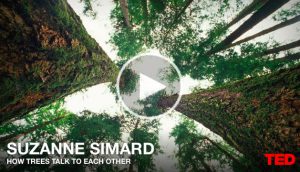. . SUSTAINABLE DEVELOPMENT . .
An article by Derek Markham in Treehugger
The Lorax might have spoken for the trees, but it turns out that trees can speak for themselves. At least to other trees, that is. While it’s not news that a variety of communication happens between non-human elements of the natural world, the idea of mycelia (the main body of fungi, as opposed to the more well-known fruiting bodies – mushrooms) acting as a sort of old-school planetary internet is still a fairly recent one, and may serve as a spore of a new breed of forestry, ecology, land management.

TED talk by Suzanne Simard
Paul Stamets famously posited that “mycelia are Earth’s natural Internet,” and a variety of research has borne out that concept, but like many things we can’t see an obvious connection between, most of us tend to ignore the micro in favor of the macro. And when it comes to conservation and natural resources, our systems may be falling prey to the lure of reductionist thinking, with a tree being considered merely a commodity in the forest, which can be replaced simply by planting another tree. In fact, many reforestation efforts are considered successful when a large number of trees are replanted in areas where clearcutting has rendered large tracts of land treeless, even if those replanted trees are essentially turning a once diverse forest into a monocropped ‘farm’ of trees.
(Article continued in the right column)
When you cultivate plants, do you cultivate peace?
(Article continued from the left column)
A recent talk at TEDSummit 2016 by forest ecologist Suzanne Simard seems to put the lie to the idea that a forest is merely a collection of trees that can be thought of as fully independent entities, standing alone even while surrounded by other trees and vegetation. As Simard, who has put in about three decades of research work into Canada’s forests, puts it, “A forest is much more than what you see.”
“Now, we know we all favor our own children, and I wondered, could Douglas fir recognize its own kin, like mama grizzly and her cub? So we set about an experiment, and we grew mother trees with kin and stranger’s seedlings. And it turns out they do recognize their kin. Mother trees colonize their kin with bigger mycorrhizal networks. They send them more carbon below ground. They even reduce their own root competition to make elbow room for their kids. When mother trees are injured or dying, they also send messages of wisdom on to the next generation of seedlings. So we’ve used isotope tracing to trace carbon moving from an injured mother tree down her trunk into the mycorrhizal network and into her neighboring seedlings, not only carbon but also defense signals. And these two compounds have increased the resistance of those seedlings to future stresses. So trees talk.” – Simard
I’m a bit of a fungi nerd, and with good reason, as fungi are one of the key elements of life on Earth while being one of the least understood, at least in terms of the sheer volume of varieties and how they interact with the rest of the systems on the planet. I’m currently reading Radical Mycology: A Treatise on Seeing and Working With Fungi, which is an incredible foray into the world of fungi, and was kind of blown away by the fact that of an estimated 15 million species on Earth, some 6 million of them may be fungi, and yet only about 75,000 of them, or 1.5%, have been classified as now. This means that the study of mycology is one of the areas of the life sciences that is still relatively untapped, and because of what we’re now starting to learn about fungal networks and mycelial ‘internets,’ could be a key element in our journey to a more sustainable world.
(Thank you to Janet Hudgins, the CPNN reporter for this article.)